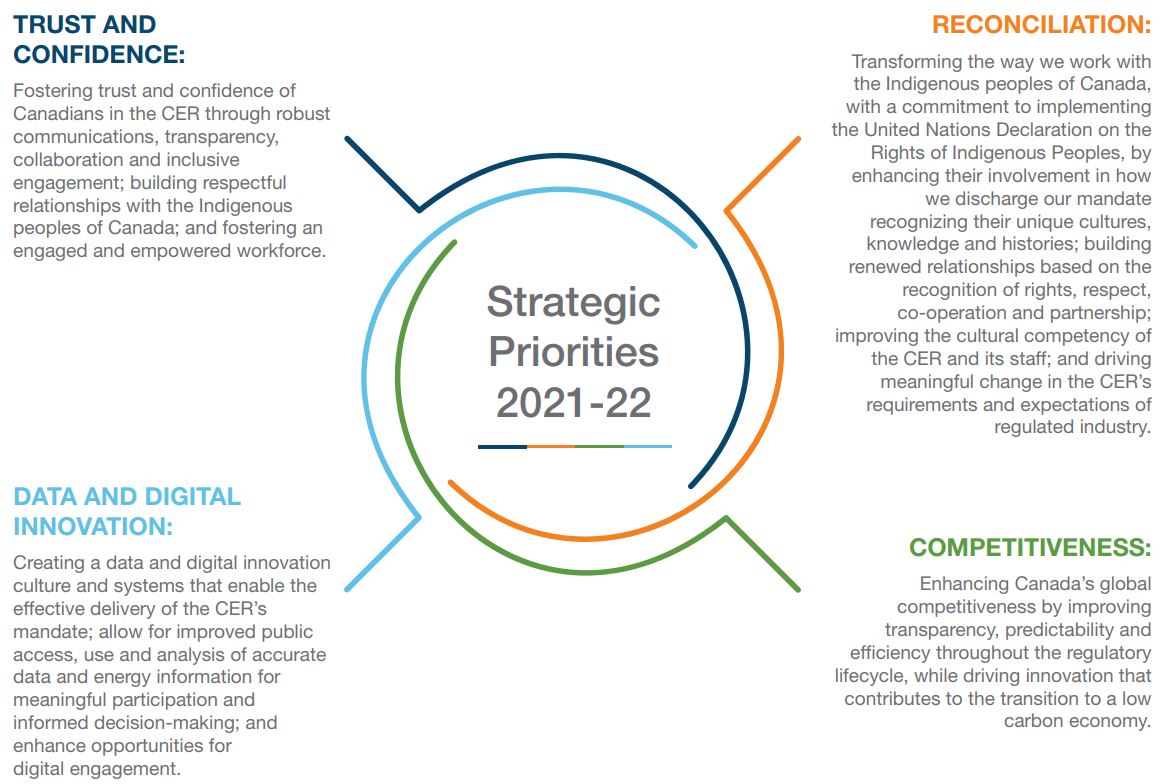Canada Energy Regulator – The First Full Year
Launched in the summer of 2019, the Canada Energy Regulator’s first full fiscal year in operation was 2020-21. In that relatively short period of time, the CER has established its footing and made great strides to fulfil the scope and intent of its authority and responsibilities under the organization’s founding legislation, the Canadian Energy Regulator Act.
While the CER’s first full fiscal year in operation was overshadowed by the pandemic, the organization made significant progress in advancing its important work as the country’s national energy regulator.
Strategic Plan
One of the CER’s most important achievements in 2020-21 was the completion of its first Strategic Plan. Setting the strategic direction for the organization is central to the role of the Board of Directors. Once the Board set the new Strategic Plan, which took effect on April 1, 2021, it became the role of the CEO to lead its implementation as part of the day-to-day business of the organization.
The CER’s new Strategic Plan includes an updated CER Mission, Vision and four Strategic Priorities.
The Vision is aspirational, capturing the type of regulator the CER strives to be and furthering commitments outlined in the preamble of the CER Act.
The Mission aligns with the CER’s mandate, as described in its enabling legislation. The organization’s Mission also states that safety is at the core of the CER’s mandate and is further framed with a commitment to respecting the rights of Indigenous peoples of Canada and continuing the CER’s work in energy information.
Vision
An energy regulator with an exemplary workforce that has the confidence of Canadians; is dedicated to ensuring safety and environment sustainability; builds strong relationships with First Nations, the Métis, and the Inuit; and enhances Canada's global competitiveness.
Mission
Regulating infrastructure to ensure safe and efficient delivery of energy to Canada and the world, protecting the environment, recognizing and respecting the rights of the Indigenous peoples of Canada, and providing timely and relevant energy information and analysis.
Strategic Priorities
For the past several years, the CER has identified priorities in which it would strategically focus program activities. These Focus Areas extended beyond the outcomes of any one program or core responsibility. They required cross organizational leadership to drive a systematic shift in the way the CER delivered services to Canadians.
For 2020-21, the term ‘Focus Area,’ which was incorporated in the organization’s previous Strategic Plans, has been replaced in the CER’s new Plan with the term ‘Strategic Priority.’
The organization’s new Strategic Plan has four Strategic Priorities, which include; Trust and Confidence, Reconciliation, Competitiveness and Data and Digital Innovation. These Strategic Priorities build and expand upon the exceptional work done to date in the CER’s Focus Areas.
Two of the Focus Areas from 2020-21 – ‘Reconciliation with Indigenous Peoples’ and ‘Data Transformation’ – are included in the CER’s new Strategic Plan as Strategic Priorities. The third Focus Area - ‘People and Workforce’ - has been elevated in the new Strategic Plan, as it is now made permanent in the organization’s Vision statement. The Focus Area on ‘People and Workforce’ will also continue to form a critical element of the Trust and Confidence Strategic Priority.

Strategic Priority: Trust and Confidence
The Canada Energy Regulator is committed to delivering a regulatory system that Canadians trust.
The organization will earn that trust and the confidence of Canadians by being transparent, working collaboratively and being responsive to what it hears from stakeholders and Indigenous peoples. As the Canada Energy Regulator continues to improve and move forward in its work, it is committed to sharing its progress with Canadians in an open and transparent manner.
Having the trust and confidence of its own staff is critical to an empowered workforce. The CER will examine its own workplace practices to ensure that it is building a culture that is diverse and inclusive, where all staff feel valued and respected.
Strategic Priority: Reconciliation
The CER is committed to the ongoing process of Reconciliation with the Indigenous peoples of Canada and will continue to take meaningful actions in that direction. The organization’s efforts in advancing Reconciliation are supported by the tools found in the CER Act as well as a renewal of the CER’s relationship with Indigenous peoples – which is based upon the recognition of rights, respect, co-operation and partnership.
Changing how the organization works with Indigenous peoples is fundamental to the CER’s Reconciliation Strategic Priority; this new approach includes a commitment to implement the United Nations Declaration on the Rights of Indigenous Peoples, as well as the Calls to Action of the Truth and Reconciliation Commission.
In 2020-21, the CER undertook a number of initiatives in support of Reconciliation, including:
- Establishing the Indigenous Advisory Committee.
- Establishing a CER Business Unit focused specifically on Indigenous Relations and Reconciliation. The new Unit serves as a centre of excellence with respect to Indigenous engagement and reconciliation activities across all CER programs.
- Evaluating and collaborating on responses to advice provided by the Trans Mountain and Enbridge Line 3 Indigenous Advisory and Monitoring Committees.
- Integrating Indigenous knowledge and insights from Elders and Knowledge Keepers into its compliance monitoring work.
- Collaborating with several government departments on the development of an Indigenous Knowledge Policy.
- Drafting an Indigenous Recruitment and Reconciliation Strategy: As one way to improve the cultural competency of the CER and its staff, the CER began to develop an Indigenous Recruitment and Retention Report. This approach sets a direction and establishes priorities to cultivate an Indigenous Inclusive workforce and attract, retain and advance Indigenous employees.
- Increasing the CER’s individual and collective cultural competency through training that responded to Call to Action #57 of the Truth and Reconciliation Report.
- Establishing a CER Indigenous Employee Circle.
Establishment of the Indigenous Advisory Committee
The CER’s Indigenous Advisory Committee was launched in August 2020 to fulfil a legislative requirement to establish an advisory committee to enhance the involvement of Indigenous peoples in the CER’s regulated infrastructure.
The overarching role of the IAC is to provide broad and strategic advice directly to the Board of Directors about how the CER can build a renewed relationship with First Nations, the Métis Nation and Inuit communities.
Through its initial meetings, the IAC provided sound advice on the CER’s new Strategic Plan, the Reconciliation Strategic Priority and the organization’s ongoing work on its approach to Crown consultation.
Looking ahead, the CER’s Board of Directors will seek the IAC’s advice on approaches to Indigenous peoples’ involvement in CER regulatory oversight and on the implementation of the United Nations Declaration on the Rights of Indigenous Peoples. This advice will bring meaningful change to the way the CER works, including its expectations and oversight of the industries it regulates.
The IAC is made up of nine members, three of whom are appointed by national Indigenous organizations: the Assembly of First Nations, the Métis National Council and Inuit Tapiriit Kanatami.
Committee members reflect Canada’s diversity of Indigenous communities, languages, genders, geographies, and skills and expertise. They also are leaders at the local, regional and national level, are respected voices of their communities, bringing significant experience in the energy and natural resources sectors.
Strategic Priority: Competitiveness
The Canadian Energy Regulator Act clearly outlines the ambition for the CER’s regulatory system to enhance Canada’s global competitiveness. The CER will deliver on that commitment by moving forward with improvements to the predictability, transparency and efficiency of its regulatory processes.
Canada’s competitiveness will also be enhanced through innovations in the CER’s oversight. This will include: delivering more clarity in its regulatory requirements, streamlining processes and creating new regulatory approaches to encourage innovation. The CER will also focus on engaging with stakeholders and explore the role of the regulator in the transition to a low carbon economy.

Strategic Priority: Data and Digital Innovation
Accurate and accessible data is integral to an effective regulatory system. With a wealth of technical, environmental and socioeconomic information, the CER is determined to create a culture driven by data and digital innovation.
Building a data and innovation culture that allows for improved public access, use and analysis of data and energy information, supports more informed decision-making and better process transparency and efficiency.
By making regulatory data more structured and searchable, scientists, industry, municipalities, Indigenous peoples and Canadians from all walks of life are able to better access information for their own purposes. In turn, these communities and the CER are better equipped to gain insights on issues ranging from public safety to environmental protection to energy markets.
In 2020-21, the CER continued to build a foundation for data transformation by concentrating on three pillars:
- People – Enhancing the skills and competencies of the organization through training and recruitment. Advanced data training programs were developed to upskill staff in a wide range of data specializations.
- Data – Building the ground work to enable better analytics, decision making and public participation. New tools and practices helped streamline data and information management across the organization.
- Systems – Establishing integrated data and information systems for internal and external users. Regulatory filing systems were streamlined to improve regulatory effectiveness, while updates to digital engagement processes will help facilitate public participation.
People and Workforce
During the past year, the CER demonstrated the ability of its People and Workforce supports to adapt to meet the needs of the organization’s greatest asset – its employees.
Bettering its people management practices through training remained a cornerstone of the CER’s Human Resources approach, as the organization developed and offered training on staffing processes, Employment Equity and unconscious bias.
In support of its people, the CER enhanced employee engagement opportunities, internal communications and training, while continuing to deliver staffing, compensation, training, awards and recognition programs.
A new Labour Relations service delivery model was developed to better support CER leaders when addressing complex employee issues. The organization also launched a new Harassment and Violence Prevention Policy to ensure compliance with legislative changes to the Canada Labour Code.


